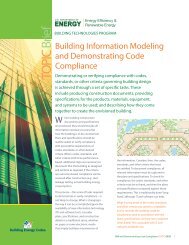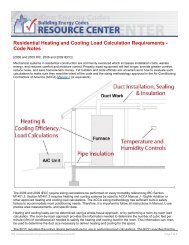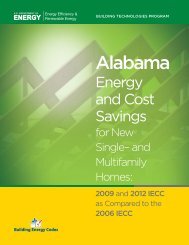(CIE) Guide - Building Energy Codes
(CIE) Guide - Building Energy Codes
(CIE) Guide - Building Energy Codes
- No tags were found...
You also want an ePaper? Increase the reach of your titles
YUMPU automatically turns print PDFs into web optimized ePapers that Google loves.
Part 2State ActionsThis section of the <strong>Guide</strong> identifies sevenstate-level actions that can be utilized to guidea state or responsible agency through a processof statewide compliance.Each of the seven actions in this section referencean action sheet that can be found under the StateAction Tab.1. Code Administration and the StateRole in ComplianceState Action Sheet 1 (SAS 1) is a high-level discussionof the value and importance of energy codes andthe rationale for compliance within your state. Italso includes an explanation of the possible codeadministration processes that can be developed ata state level for assuring more consistent statewidecode administration practices that are supportiveof energy codes.2. Formation of Statewide <strong>Energy</strong> CodeCollaborativeState Action Sheet 2 (SAS 2) lays out a processfor an energy code collaborative formation.Many states are embracing a collaborativeapproach to energy code compliance. Oneadvantage of this approach is that it providesa means and process to encourage industryand other stakeholder discussion on the issuessurrounding code compliance. By placing thechallenges and issues on the proverbial table, stateagencies can more effectively facilitate solutionsand approaches to compliance.3. Compliance ApproachesState Action Sheet 3 (SAS 3) takes Action Sheet1 to the deeper level of application. It addressessome available strategic compliance options forstate agencies. Tactical-level options that may beused by jurisdictions for plan review and inspection,and by industry in submittal to jurisdictions, can befound under Jurisdiction Action Sheets 3 through 8.4. Program EvaluationState Action Sheet 4 (SAS 4) discusses specificevaluative approaches that can be used to assesscompliance levels.5. Rating a <strong>Building</strong> for Compliance—Using the Checklists and Score+StoreState Action Sheet 5 (SAS 5) provides rationale foruse of the BECP-developed online tool for energycode compliance documentation.6. Marketing and OutreachState Action Sheet 6 (SAS 6) provides guidance forenergy code messaging for states.Maintenance and quality assurance of the code isdependent to a degree on the buy-in of the public,the building and design industry, the regulatoryauthority, and the promulgating authority. Whetheror not identified as a formal part of the traditionalcode adoption and implementation process, somelevel of marketing and outreach is always prevalentduring energy code development.7. Education and TrainingState Action Sheet 7 (SAS 7) discusses educationand training needs and provides a process forbuilding a statewide program. Though not alwaysthought of as a formal part of the adoption andcompliance processes, education and training istypically part of a traditional code adoption processand is always a necessary component for successfulcode implementation and compliance.COMPLIANCE IMPLEMENTATION AND EVALUATION (<strong>CIE</strong>) GUIDE13
















